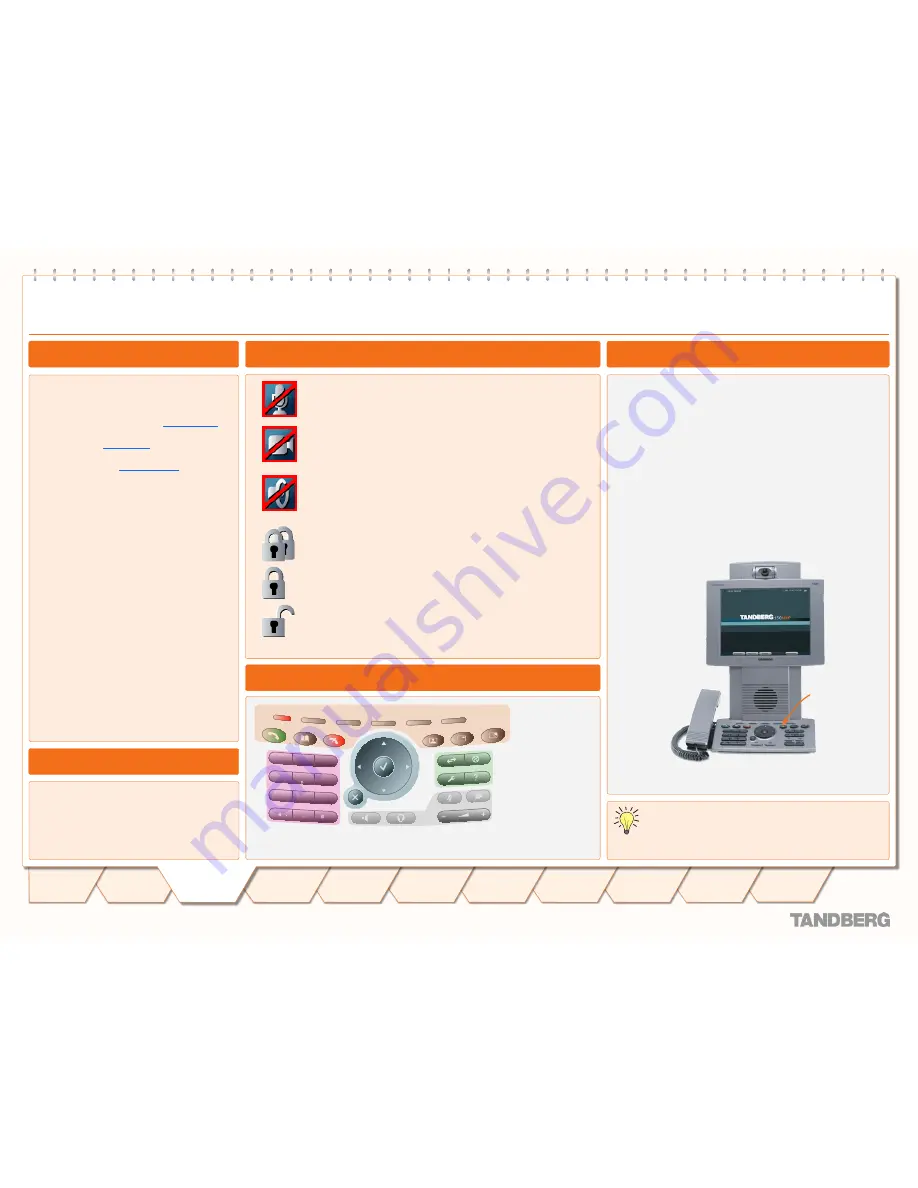
D 14067.02
02.2010
6
TANDBERG 150
MXP
USER GUIDE
Table of
Contents
Operating
Principles
Making
Video
Calls
Making
Calls Using
Phone Book
Phone Book
Details
Incoming
Calls
Calling More
Than One
Video Meeting
Features
Contact
Information
Unpacking &
Installation
Making
Telephone
Calls
Operating
principles
TANDBERG 150
MXP
USER GUIDE
Your TANDBERG 150
MXP
is capable of making
and receiving simple telephone calls in addition
to its main objective; video meeting calls.
Calls can be made by means of
speed dialling
(five presets available for immediate dialling);
by means of the
Phone Book
(which typically
consists of My Contacts and a Corporate Phone
Directory) as well as
manual dialling
(entering
the “number” manually).
When dialling manually you may also define
settings applying to your call. For presets
(Speed Dialling and Phone Book usage) these
call settings will be a part of each preset entry,
hence there will be no need to define these
every time you make a call.
Privacy.
There are some aspects of privacy
regarding incoming calls that you may want to
consider.
In particular we are thinking of such things as:
Should the microphone, as default, be switched
off, so that the far end will be unable to hear
you until you physically switch the microphone
back on? This is described in the Adminstrator’s
Guide (separate document).
What about the the camera? Should the camera
also remain switched off until you physically
switch it back on? If so, press the
Camera Off
key whilst outside a call (must be done every
time you want it).
1
2
3
abc
def
4
5
6
jkl
mno
ghi
7
8
9
tuv
wxyz
pqrs
0
a/A
Soft keys, call
keys and picture
keys
Alphanumerical
keypad
Call register,
Administrator settings
and Help
Microphone Off,
Privacy On (Camera
Off), and Volume
Control
Cursor keys, OK and
Cancel keys
You may hook up a TTY (Text telephone) to the
150
MXP
. The TTY is a device allowing hearing-
or speech impaired people to communicate
by typing and reading messages – see
Audio
Settings
in the
Adminstrator’s Guide
for more.
The Icons Appearing on the Screen
Introduction
About Making and Receiving Calls
Using TTY for Text Exchange
Microphone Off.
This indicator is shown when the microphone is
turned off. Press the
Mic Off
key again to turn the microphone back
on.
Privacy.
This indicator is shown when the
Privacy
key on the keypad
is activated. No camera images are sent from your system when
the privacy indicator is displayed. Press the
Privacy
key again to
deactivate the feature.
Volume Off.
This indicator is shown when the volume is turned off.
Press
to turn the volume back on.
Secure Conference, AES.
This double padlock indicator is shown
when AES encryption (Secure Conference) is active.
Secure Conference, DES.
This padlock indicator is shown when
DES encryption (Secure Conference) is active.
Not Secure Conference.
This open padlock indicator is shown during
the initialization phase for encryption. During this period the call is not
secure.
Your TANDBERG 150
MXP
Keypad at a Glance
Camera.
The camera has manual tilt and focus. Turn the
lens to adjust focus.
TIP!
Press
Selfview
first to see your video picture.
Tilt the camera by manually adjusting the
Tilt Angle
with
the wheel to the right of the lens.
Microphone.
Located
at the top of the unit.
Screen
Handset.
Handset is an
optional device.
Contact your
TANDBERG
representative for
more
information.
Use the
Camera lens cap
located at the rear of the
unit to cover the lens when
the unit is not in use. The
camera lens cap protects
the lens and also assures
you from involuntary
broadcasting of your video
image.
Keypad.
The keypad contains all
the keys you need to control the
system.
Selfview
key
Loudspeaker
The Different Parts of Your 150
MXP
Camera
The soft keys are context sensitive keys, whose functions
will change in accordance with what you are doing. In some
contexts they are used for Speed Dialling, in other contexts
they will be used for other functions, such as call transfer.
Details on the keys can be found
on the next page.





















